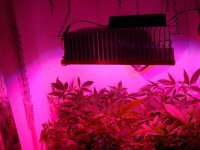SupraSPL
Member
I have been working at this for awhile and finally got it lit up today! (Thanks to KNNA for bringing me up to speed and sourcing rare parts!) $425 for materials. Using Golden Dragon Plus premium bins. 64 reds (640nm), 14 cool whites and 7 blues (450nm). Tried to get the whites and blues spread evenly as possible. Used a ton of heatsink for passive cooling and longevity (150cm2+ per watt/ 40,000+ hours with 90% lumen maintenance) I got the heatsinks on eBay for $100 cut and shipped. These are the same as the ones from Heatsink USA llc. Going to need (4) drivers to get the job done on 120v line. Since I only have 2 drivers I'm using half the modules for now.


Added the Kapton layer and copper traces. One string for red the other for blue and white. Each string has its own driver with adjustable current. Got the Kapton and copper tape from eBay.

Thermal path is LED slug->Arctic Silver Ceramique->expanded copper tape pad->Kapton Layer->Heatsink. I did the soldering outside in the frigid deep winter. Luckily the solder I had was lead/silver and melted very fast even with an old 30 watt iron. Once I had my technique down each led only took a few seconds. I drilled a few small holes in the fins and zip tied the leads to relieve stress on the solder points. I also drilled holes for the chains to hang them.

I am not using lenses or reflectors. These modules will be hung about 6" from the canopy and the plants are LSTd so will not grow taller than ~15" or so above the soil. These suckers are so bright I prefer not to look at it even from off angle. Looking into these emitters directly would be a very bad idea. Without flash:

With flash:

Update: I finally got a new multimeter and set the driver levels.
*The LEDs will dissipate 143.2 watts.
*Input power will be 162 watts.
*Average driver efficiency is 88.4%.
*Each red will dissipate 1.4 watts @600mA and Vf of 2.3.
*Each white/blue will dissipate 2.4 watts @700mA and Vf of 3.5.
I would have liked to add some 660nm but as far as I know there are none available on the AlInGaP chips yet which are 2X more efficient. Update: These are coming soon.
I can't believe how much light these are putting out, especially when I consider from a plant's point of view it is even brighter still.


Added the Kapton layer and copper traces. One string for red the other for blue and white. Each string has its own driver with adjustable current. Got the Kapton and copper tape from eBay.

Thermal path is LED slug->Arctic Silver Ceramique->expanded copper tape pad->Kapton Layer->Heatsink. I did the soldering outside in the frigid deep winter. Luckily the solder I had was lead/silver and melted very fast even with an old 30 watt iron. Once I had my technique down each led only took a few seconds. I drilled a few small holes in the fins and zip tied the leads to relieve stress on the solder points. I also drilled holes for the chains to hang them.

I am not using lenses or reflectors. These modules will be hung about 6" from the canopy and the plants are LSTd so will not grow taller than ~15" or so above the soil. These suckers are so bright I prefer not to look at it even from off angle. Looking into these emitters directly would be a very bad idea. Without flash:

With flash:

Update: I finally got a new multimeter and set the driver levels.
*The LEDs will dissipate 143.2 watts.
*Input power will be 162 watts.
*Average driver efficiency is 88.4%.
*Each red will dissipate 1.4 watts @600mA and Vf of 2.3.
*Each white/blue will dissipate 2.4 watts @700mA and Vf of 3.5.
I would have liked to add some 660nm but as far as I know there are none available on the AlInGaP chips yet which are 2X more efficient. Update: These are coming soon.
I can't believe how much light these are putting out, especially when I consider from a plant's point of view it is even brighter still.





 Do they kick off enough heat that they're warm to the touch, or hot enough you can't touch for more than a few seconds?
Do they kick off enough heat that they're warm to the touch, or hot enough you can't touch for more than a few seconds?





